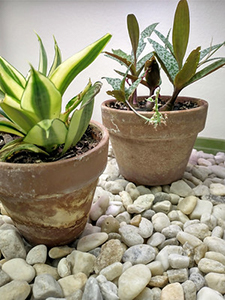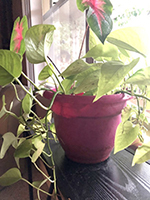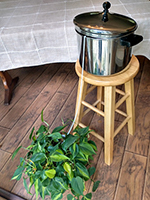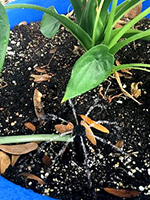Vacation Plant Care

Pebble tray method. Credit: UF/IFAS
As a gardener, you lovingly care for your plants and landscape. Unfortunately you can't pack them up and bring them on your vacations with you. However, with a little planning and preparation, your plants will remain healthy while you enjoy your adventure away.
Possibly the most important consideration is your plants' water needs. Below are our suggestions for keeping your indoor and outdoor plants hydrated while you're away.
Indoor Plants
Having someone care for your indoor plants while you're away is a good idea, but another option is self-watering containers. This way, even if you can't find a plant-sitter, you can still be worry-free when you leave town. Here are a couple of options.
One to two weeks away
Self-watering containers allow plants to take up water as needed from a reservoir. Move houseplants away from warm windows and direct sunlight to a place where they receive only indirect sunlight. For a couple of weeks they can survive on lower light and they will take up less water in the meantime.

A self-watering pot. Credit: Wendy Wilber, UF/UFAS
For plants not in a self-watering container, adding a saucer beneath them is another option. Fill a deep saucer or a shallow bowl with pebbles and then with water. Set the plant you'd like to keep moist on top and water thoroughly before you leave. This method can buy you an extra week of time before you'd need to water again.
For plants that need more water, or for large groups of plants, you can use your bathtub as the saucer. Fill the bathtub with 2 inches of water, add old towels in place of pebbles, and set the plants on top. Leave the light in the bathroom on and you plants should be safe from dehydration for a week longer than normal.
Three to four weeks away
For extended periods away, a wicking method can help. Fill a large bowl, pot, or bucket with water to act as a reservoir. Place it on a table or chair above a group of houseplants, but not between the plants and their light source. Run cotton cords or wicks from the bottom of the water reservoir, over the side, and down to the soil of each potted plant. Water will run down the wick and into the soil, keeping it moist for an extra couple of weeks, but don't forget to water your plants before you go.
For periods away from your plants longer than 4 weeks, we recommend sending your plants to your plant-sitter's home. Even if the moisture levels are perfect, pest issues can get out of hand quickly when plants are stressed. Fungus gnats, aphids, and mites don't make for a warm welcome home. If your plants are too big to move, have the plant sitter visit your home at least once a week to check on them.

Wicking method. Credit: UF/IFAS
Outdoor Plants
As with indoor plants, a trusted plant-sitter is probably the best solution but there are other options. Regardless, before you leave, give your landscape plants a good, deep watering. This will allow the roots to take up as much water as they can before you go off on vacation. Make sure that you apply enough water to wet the top 12 inches of soil. This is where most of a plant's roots reside, no matter how large or small it is.
Irrigation Systems
One way to be sure your plants stay well-watered is to schedule your automatic irrigation system if you have one. Per Florida law, the system should have a rain sensor so that your plants don't receive unnecessary irrigation. If you can, have someone check in at least once a week to be sure everything is running smoothly. If you don't have an automated system, you can purchase a timer for your hose-end sprinkler.
Whichever option you choose, make sure you only schedule waterings for the times and days allowed by local ordinances.
Landscape Beds and Lawns
Refreshing the mulch in your landscape is another way to keep your plants from drying out while you are away. A three-inch layer of mulch helps the soil retain moisture and insulate roots from high summer temperatures. Since you won't around to monitor your plants and soil, the added insulation can make a big difference if temperatures climb. If you have landscape beds without a three-inch deep layer of mulch or leaf litter, consider mulching before you leave.

Microbubbler. Credit: Anne Yasalonis, UF/IFAS
While you're at it, don't forget the lawn. If you are going to be gone for more than a week, arrange for someone to mow the grass and try to mow the day before you leave. If you let the lawn grow for too long, you may have trouble removing only 1/3 of the blade when you return. Removing more than that at one time is unhealthy for your turf.
Container Plants
Outdoor container plants are probably the hardest to plan for. They are exposed to the elements and have very little soil to hold moisture. They also don't receive the insulation that soil provides in-ground plants. If you're leaving for more than a couple of days, group container plants together. Groups of plants will conserve water better than containers spread out across your porch or landscape. It also saves time for anyone stopping by to water your plants. Containers can also be moved to a shady place. Mulch can be added to potted plants to conserve moisture just as you would add it to landscape beds.
If you don't have someone able to stop by and water, a simple microirrigation set-up and a timer can help. Connect a length of soaker hose or several drip emitters to the end of a traditional, non-permeable hose. Snake the soaker hose or emitters along the tops of the grouped containers, making sure they receive water evenly. Add a timer to your outdoor faucet to automatically turn on the microirrigation system every couple of days. If you decide to try this setup, it's best to install it a week in advance to perfect the timings before you leave.
For more information on keeping your plants healthy and happy, contact your county Extension office.
Also on Gardening Solutions
- All About Water Restrictions
- Caring for Houseplants
- Container Gardening
- Houseplants for the Forgetful Gardener
- Setting Your Irrigation Timer
- Watering the Vegetable Garden

